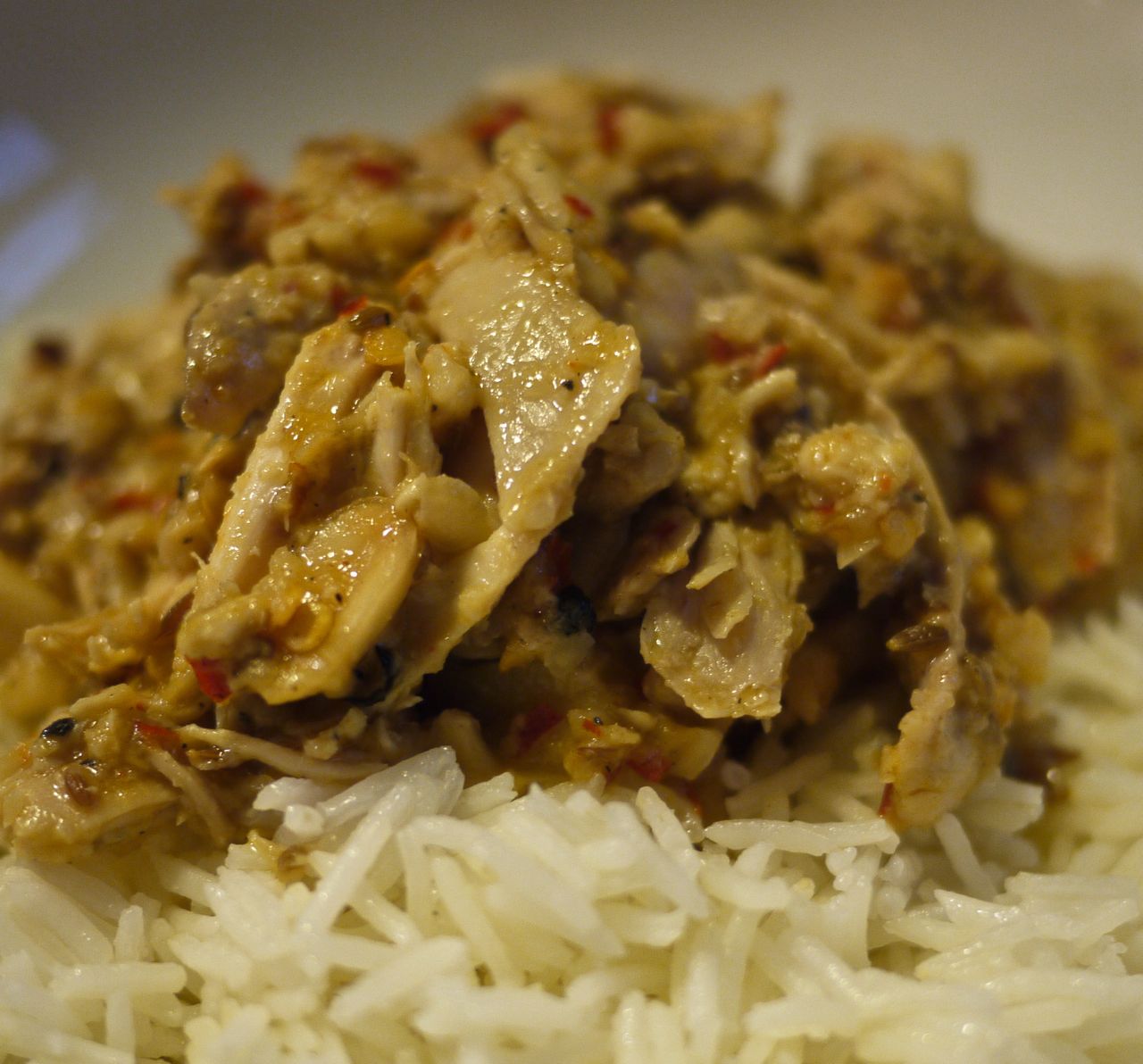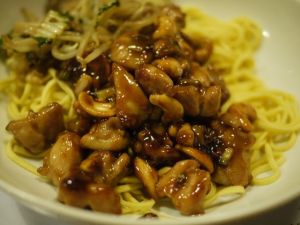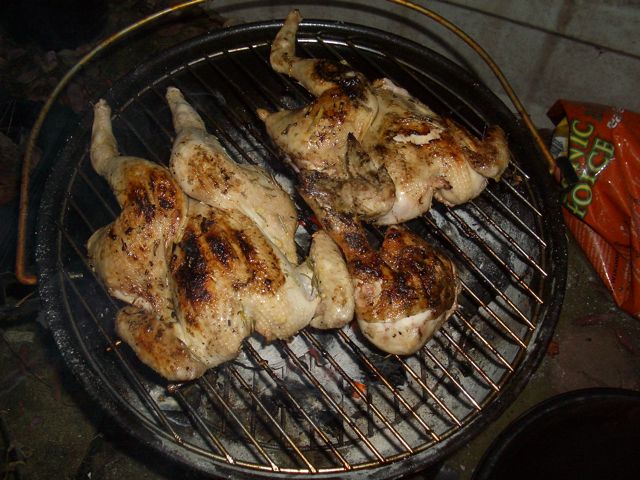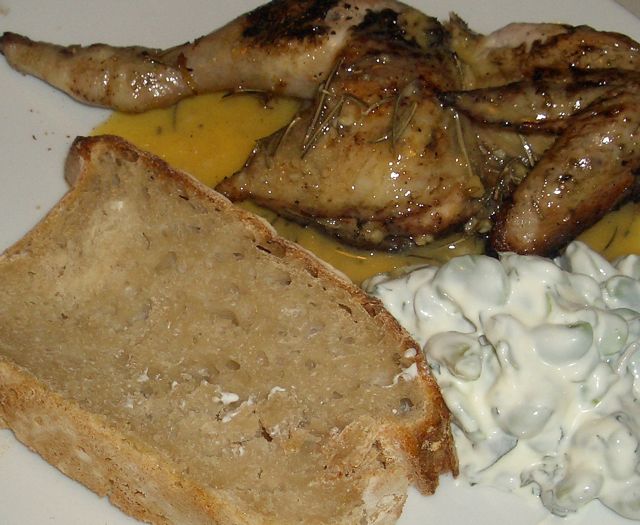At the end of March I went off to the depths of Suffolk to meet Veronica from Leaf House. She’d asked me to come and visit to talk about how I might be able to help her as she switched the focus of her business. She also promised to make me a curry for lunch. We had a great day chatting business stuff and I can report that the curry was A-Mazing.
So I made sure I got the recipe. I’ve made it twice so far and it really is simple and gorgeous. Don’t be put off by the long list of ingredients for the paste its worth it.
This is the recipe as Veronica gave it to me, with my adaptations in brackets:
First you have to make the red curry paste but you can blitz this to make it easier (I did and it was super easy). And you will have heaps left over to either make this one again or just use it for a ‘normal’ red curry 9I did half the amount so had none leftover). If you blitz rather than pound the paste, its a good idea to do at least day before so flavours ‘meld’ together (I didn’t I wasn’t that organised).
Red Curry Paste
nb.. recipe is from an Australian book ‘Thai Cuisine’ by Mogens Bay Esbensen… 1 cup = 250mls and 1 tablespoon is 20ml
1 cup shallots (red onions) chopped
1 cup garlic, chopped
1 cup lemon grass, tender parts only, chopped (I didn’t have any)
2 tablespoons coriander root (I didn’t have any of this either)
2 tablespoons galangal/laos root… fresh or dried, chopped
2 teaspoons peppercorns
2 teaspoons coriander seeds, roasted
2 teaspoons cumin seeds, roasted
2 teaspoons lime or makrut zest, grated
1 teaspoon nutmeg, ground (I didn’t add this as am not much of a nutmeg fan)
1 teaspoon mace (I didn’t have any)
20 – 30 dried red chillies (I used chilli flakes about 2 teaspoons worth)
4 tablespoons shrimp paste (kapee) (didn’t have any of this either)
2 tablespoons salt
Grind all together really well. Store in large, well sealed jar in the fridge. Keeps well. (As you can see I didn’t have lots of the ingredients BUT it still made a lovely curry)
Panang Gai.. dry chicken curry
750g chicken breast (I used left over roast chicken as that what I had and it was a mix of breast and leg meat)
1 tablespoon fresh or tinned green peppercorns, crushed (didn’t have any)
50g plain flour (ooops forgot this)
100ml vegetable oil
50g red curry paste
250ml coconut cream (not milk)
25g sugar
40ml fish sauce
60g roasted peanuts, chopped
Basil leaves to garnish.
Remove skin from chicken and cut into bite sized pieces. Rub crushed green peppercorns into the chicken meat and then toss in flour (obviously I didn’t do this bit). Heat oil in wok and stir fry chicken pieces until well coloured and nearly cooked. Remove chicken to platter and set aside.
Add curry paste to wok and stir fry for 2 minutes. Stir in coconut cream, sugar, fish sauce and peanuts. Stir well for 5 minutes.
Toss in chicken and coat with the thick sauce. Turn out onto serving platter and garnish with basil leaves.
note: I cooked the curry paste and sauce first and cooked for longer to thicken it as I hadn’t used flour, probably for 10 minutes. Then I added the chicken and cooked for another 10 minutes. I added some bamboo shoots at the end because I had some.
I think the secret is in making the spice paste it seems to give a much better tasting result.



 Here’s the easy chicken (well poussin actually) we did last night:
Here’s the easy chicken (well poussin actually) we did last night: We had homemade sourdough bread to mop up the sauce/juices and broad beans tossed in minty yoghurt.
We had homemade sourdough bread to mop up the sauce/juices and broad beans tossed in minty yoghurt.
 You’ll be please to know that
You’ll be please to know that  Now I know you can say its not exactly home cooking to use ready made pastry and if it had been shortcrust that was needed I might have made my own as I’m finally quite good at it. I used to be rubbish at pastry but I think your hands just get colder as you get older so you get better without trying – at least in relation to making shortcrust pastry ;). But I find that a hot meaty pie needs a puff pastry top because really I love the way it gets all crispy on the top and soggy next to the filling without ending up too heavy or stodgy. Plus we have to remember that sometimes a few quick cheaty bits in the kitchen help to deliver a different dish – if I’d thought I’d have to make puff pastry myself, something not attempted since domestic science at school (such a great name to inspire teenagers to cook –what were they thinking) then there’d have been no pie.
Now I know you can say its not exactly home cooking to use ready made pastry and if it had been shortcrust that was needed I might have made my own as I’m finally quite good at it. I used to be rubbish at pastry but I think your hands just get colder as you get older so you get better without trying – at least in relation to making shortcrust pastry ;). But I find that a hot meaty pie needs a puff pastry top because really I love the way it gets all crispy on the top and soggy next to the filling without ending up too heavy or stodgy. Plus we have to remember that sometimes a few quick cheaty bits in the kitchen help to deliver a different dish – if I’d thought I’d have to make puff pastry myself, something not attempted since domestic science at school (such a great name to inspire teenagers to cook –what were they thinking) then there’d have been no pie. Roll out your home made (swot) or cheaty pastry (top marks for thinking ahead) to a good inch larger than the pie dish. Cut off about ½ inch of this extra and use it to create a pastry rim round the dish – even if you don’t need one it means there’ll be some extra crispy crust. Moisten the pastry rim and the lid and apply lid to rim. Pinch together with your fingers then knock up the edges with a knife to help give some extra lift. Cut a slit to allow the steam out. Apply decorative pastry patterns with any remaining pastry. Into the oven it goes – gas 6 (200C/400F) for around 30 minutes to cook the pastry.
Roll out your home made (swot) or cheaty pastry (top marks for thinking ahead) to a good inch larger than the pie dish. Cut off about ½ inch of this extra and use it to create a pastry rim round the dish – even if you don’t need one it means there’ll be some extra crispy crust. Moisten the pastry rim and the lid and apply lid to rim. Pinch together with your fingers then knock up the edges with a knife to help give some extra lift. Cut a slit to allow the steam out. Apply decorative pastry patterns with any remaining pastry. Into the oven it goes – gas 6 (200C/400F) for around 30 minutes to cook the pastry.

 Get the chicken carcass and any bones you’ve saved from using up the leftovers so far. Strip all the good useful meat of the carcass but don’t be too fussy about this – leaving some meat on the bones will add to the flavour of the final stock. Bung all the bones, any really scrappy meat, the carcass and the skin i.e. anything chicken-y, into the stockpot.
Get the chicken carcass and any bones you’ve saved from using up the leftovers so far. Strip all the good useful meat of the carcass but don’t be too fussy about this – leaving some meat on the bones will add to the flavour of the final stock. Bung all the bones, any really scrappy meat, the carcass and the skin i.e. anything chicken-y, into the stockpot. Next add the vegetables and herbs that are going to help flavour things. Read any cookery book and even if they tell you that you shouldn’t be using leftover roast (ignore them, they are wrong, stick with me, Nigella Lawson, Jamie Oliver and Hugh Fearnly-Whittingstall) they will tell you to add the pretty much holy trinity of onion, carrot and leek – so do that. One medium onion (in quarters), a couple of reasonable size carrots cut in chunks (no need to peel unless you can’t manage to get all the soil off any other way) and a leek (all of it except the very bottom – no throwing those green tops away) again cut into chunks and rinsed so you don’t get sandy soil in the stock. Also good to add is celery – a couple of stacks – chunks again. On the herb/spice front you need some whole black peppercorns (6 or so), a bay leaf or two and a spring of parsley or thyme.
Next add the vegetables and herbs that are going to help flavour things. Read any cookery book and even if they tell you that you shouldn’t be using leftover roast (ignore them, they are wrong, stick with me, Nigella Lawson, Jamie Oliver and Hugh Fearnly-Whittingstall) they will tell you to add the pretty much holy trinity of onion, carrot and leek – so do that. One medium onion (in quarters), a couple of reasonable size carrots cut in chunks (no need to peel unless you can’t manage to get all the soil off any other way) and a leek (all of it except the very bottom – no throwing those green tops away) again cut into chunks and rinsed so you don’t get sandy soil in the stock. Also good to add is celery – a couple of stacks – chunks again. On the herb/spice front you need some whole black peppercorns (6 or so), a bay leaf or two and a spring of parsley or thyme.